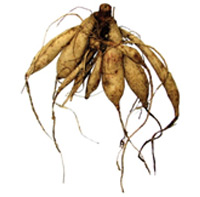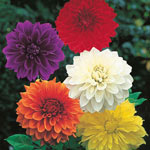- About Bulbs
- Landscaping Tips
- Planting & Care of Bulbs
- Tips for buying Bulbs & Perennials
- Planting & Growing Instructions
- Allium Planting and Growing Tips
- Astilbe Planting and Growing Tips
- Begonias Planting and Growing Tips
- Calla Lily Planting and Growing Tips
- Crocus Planting and Growing Tips
- Daffodil Planting and Growing Tips
- Dahlia Planting and Growing Tips
- Daylily Planting and Growing Tips
- Gladiolus Planting and Growing Tips
- Hosta Planting and Growing Tips
- Hyacinth Planting and Growing Tips
- Iris Planting and Growing Tips
- Lily Planting and Growing Tips
- Peony Planting and Growing Tips
- Rose Planting and Growing Tips
- Tulip Planting and Growing Tips
Tips for Caring, Growing and Planting Dahlia Tubers
Dahlia flowers provide months of color during the summer months, blooming from midsummer until the first frost. They are also good as cut flowers in floral arrangements. You'll have a successful dahlia season when following these tips on growing dahlias.
How to Plant Dahlia Tubers
Dig a hole that's about 6-8" deep and amend the soil with peat moss or compost. Replace about half the soil, then place tubers with the flower stalk facing up and cover with 2" of soil. Space dahlia tubers 12-36" apart depending on variety. Water after planting and not again until shoots appear.Where to Plant Dahlias
Choose a site with the following characteristics:- Full sun to partial shade
- Well-drained soil of any type, from clay to sand, and any pH level
Full sun produces sturdier dahlias, but sites with morning sun and afternoon shade, or dappled sun throughout the day, are also acceptable. During the summer months, make sure the soil does not dry out; insufficient moisture causes slow growing dahlias, fewer flowers, and yellowing of the foliage. Dahlias are tolerant of a wide range of pH, and adjusting the pH is normally not necessary.
When to Plant Dahlia Tubers
Since dahlia tubers are tender bulbs, you'll want to plant dahlias outdoors after all danger of frost has passed. Dahlias are known to struggle in cold soil so it's important that your ground soil reaches a minimum of 60°F before planting them.Preparing Soil for Dahlias
It is worth taking the time to dig a proper hole and amend the soil. You'll get bigger, healthier plants with more flowers.
Spade or rototill the soil to a depth of 12-15". Mix in a generous, 2-4" layer of dehydrated manure, garden compost and Breck's® Food for Bulbs and Perennials. If your soil is already a rich garden loam and well-drained, the addition of Breck's Food for Bulbs and Perennials will provide the ideal conditions recommended by Breck's Dutch bulb experts for superior growth and blooming. If you have clay soil, which is a heavy soil, you may need to amend for drainage. A good solution is to mix compost, sand and rock dust or crushed stone into your soil. If you have sandy soil, amend with compost and possibly clay to increase the retention of nutrients. This will also help retain moisture.
How To Care For Dahlias and Dahlia Bulbs
Our high quality dahlia tubers are harvested in Holland and kept cool until they are shipped to the US to our customers. Dahlias prefer drained soil but need to be watered regularly. Plant dahlias in full sun about 12 to 18 inches apart and 6 to 8 inches deep. Pinch the top of your dahlia plants above the 4th set of leaves for more blooms.How to Mulch Dahlias
A thin layer (1-2") of mulch (compost or a commercial type of mulch) has a positive effect on your dahlias by retaining moisture, maintaining a more even soil temperature, providing organic matter for an optimal soil structure and reducing weed growth. It also prevents soil from splashing onto the flowers and foliage.
How to Fertilize Dahlias
A surface application of Breck's® Food for Bulbs and Perennials at planting time is recommended. In poor soils, plants may benefit from a second application in early to midsummer. If natural rainfall is less than 1" per week, additional watering is recommended.
How to Pinch Dahlias
Though dahlias will grow just fine on their own, pinching will give you a stronger, bushier plant with more flowers. The best time to pinch a dahlia is when it's between 12-16" tall and has at least four sets of leaves on the center stalk. Locate the upper-most sprout on the main stem and remove it with your fingers or a pair of scissors. Take care not to damage the stem or nearby leaves.
If you want the largest flowers possible, you should not pinch. For this purpose, remove axillary shoots. This allows the main flower to blossom to its fullest potential. Just pull out the buds that are growing next to the main flower.
How to Stake Dahlias
Tall dahlias may require staking, especially in windy areas. At planting time, insert a means of support, like flower support rings.
How to Deadhead Dahlias
We suggest removing spent flowers on a regular basis, for instance, once a week to best care for dahlia plants. Deadheading encourages your dahlia to put its energy into producing more flowers, thereby promoting an extended display of form and color in the garden.
Dahlias as Cut Flowers
Dahlias make excellent cut flowers. The ones best suited have a vase life of 7-10 days. Pick flowers that are nearly or fully open because the buds will not open once they're cut in most cases. On warm days, harvest early in the morning or late in the afternoon. Strip off all leaves that would be below the water line in your vase. Nutrients for cut flowers (floral preservatives) stimulate the flowers to open, extend the vase life and keep the water in the vase clean.
How to Plant Dahlias in Pots
Dahlias can be started indoors in individual pots with damp peat moss and vermiculite. You must use caution when transplanting them outdoors. Plant dahlias outdoors after all danger of frost has passed.When are Dahlias in Season?
Dahlias are in season between the months of May and October.
When do Dahlias Bloom?
Dahlias usually bloom eight weeks after planting and during mid-summer and throughout the fall season. Some also say that if you're able to grow tomatoes in your garden, that you'll be able to successfully and easily grow dahlias as well.Are Coffee Grounds Good for Dahlias?
Yes! Dahlias like coffee grounds and the coffee grounds make for a wonderful fertilizer. Since coffee grounds usually contain about 2% nitrogen, a third percent of phosphoric acid, and roughly 1% of potassium, the coffee grounds act as an excellent fertilizer for your dahlia garden.How To Treat Common Dahlia Pests and Diseases
- Coffee grounds spread around the plants.
- A beer trap. A container such as a glass jar or large yogurt pot sunk into the ground so the rim is at or just above soil level, filled with beer acts as a slug trap.
- Organic slug pellets. Approved for use in organic gardening and completely non-toxic to other animals.
Overwintering Dahlia Tubers
If you live in a cold zone, you'll want to lift and store your dahlia tubers over the winter. Here are some quick tips:Gall on Dahlia Tubers
Gall on dahlia tubers is a plant health issue that gardeners dread. This condition, often referred to as crown gall or leafy gall, leads to unsightly growths that can impair plant vitality.
But what exactly is gall on dahlia tubers? Essentially, it's a bacterial infection that causes the plant to produce excessive tissue, forming galls. These galls can vary in appearance from leafy protrusions to rounded, tumorlike swellings at the crown of the tuber.
Recognizing and addressing gall on dahlia tubers early is crucial for maintaining healthy, beautiful dahlia plants in your garden. To prevent or manage crown gall or leafy gall on dahlia tubers, focus on these key strategies:
These steps can significantly reduce the incidence of gall on your dahlia tubers.
Popular Dahlia Varieties
You May Like...












